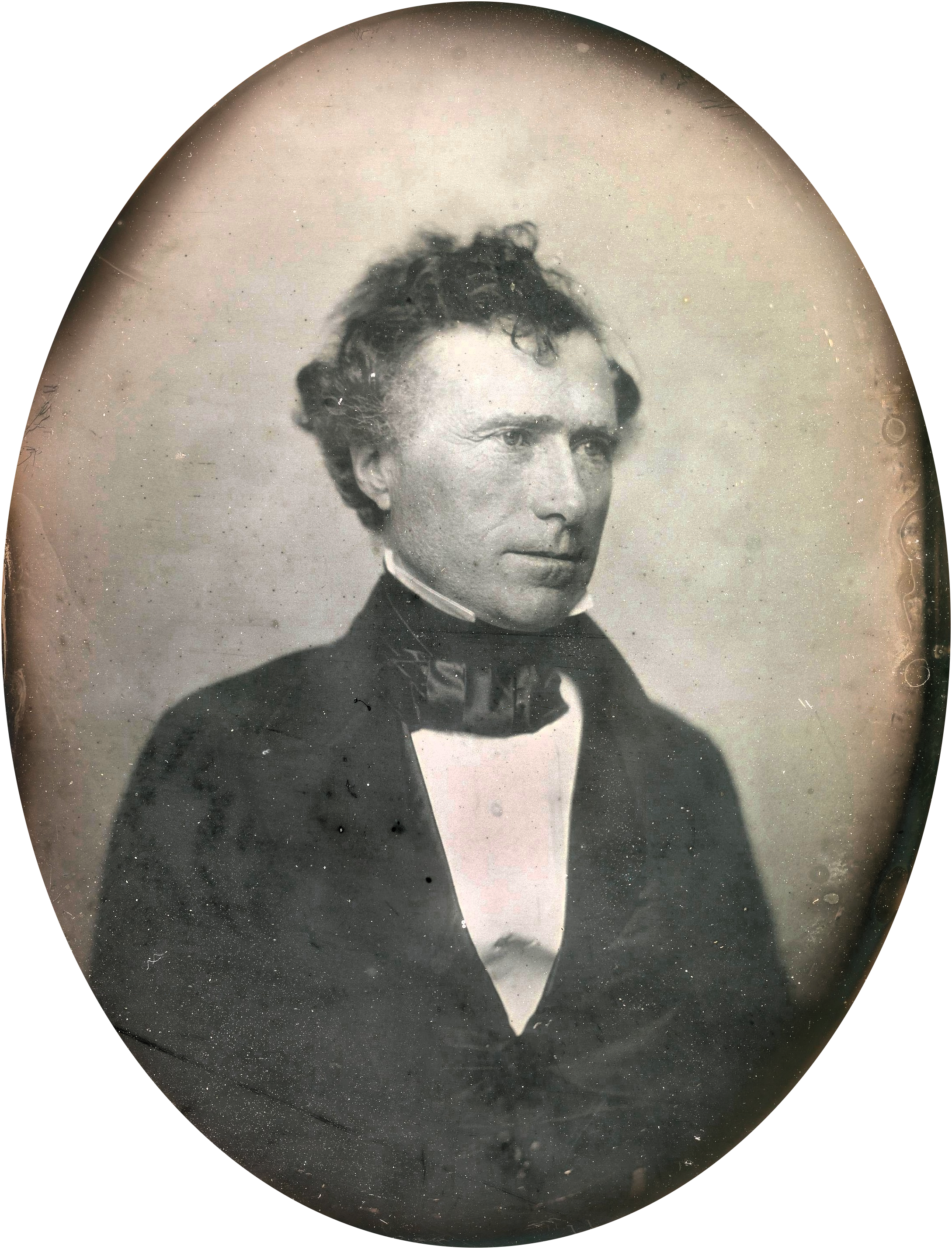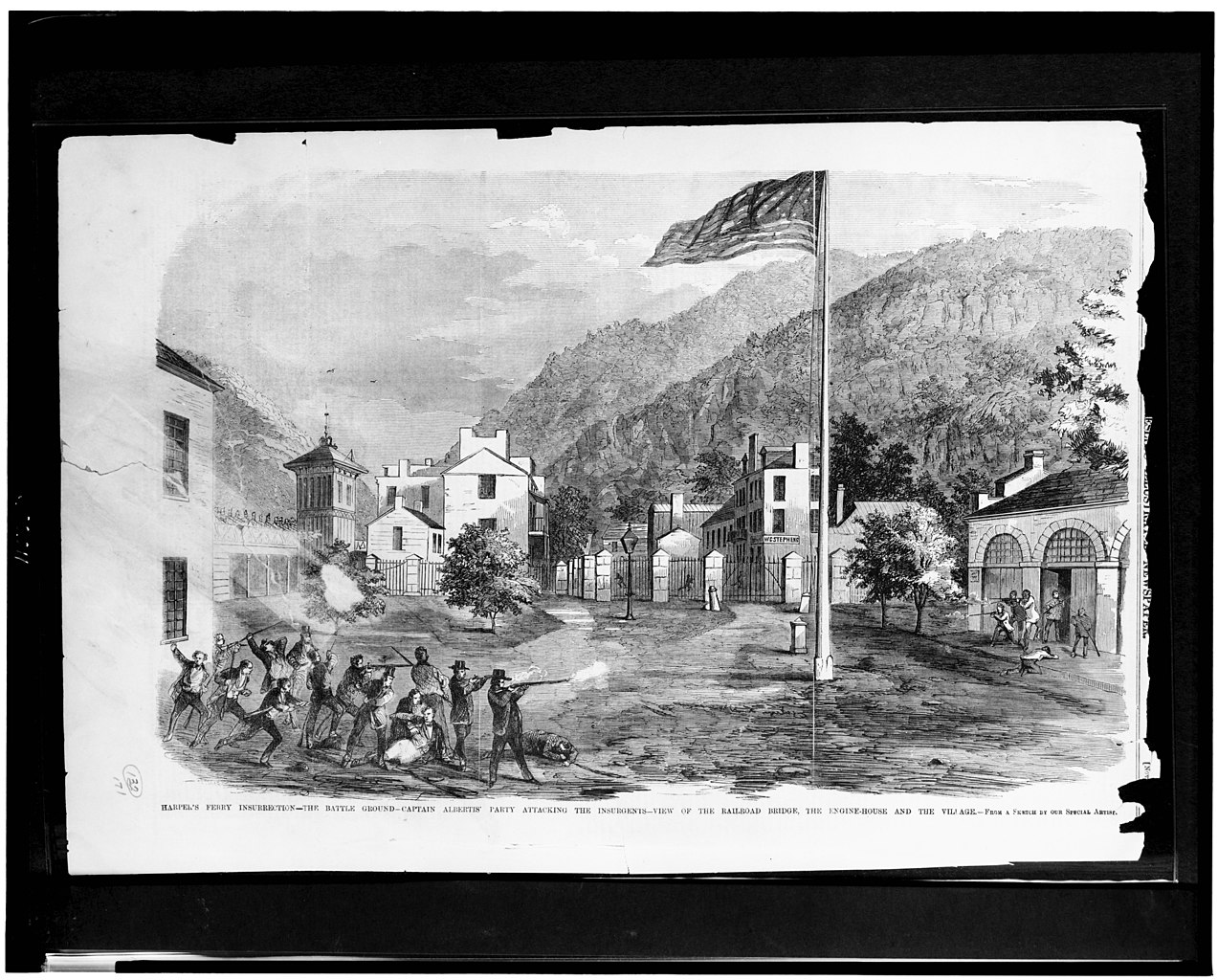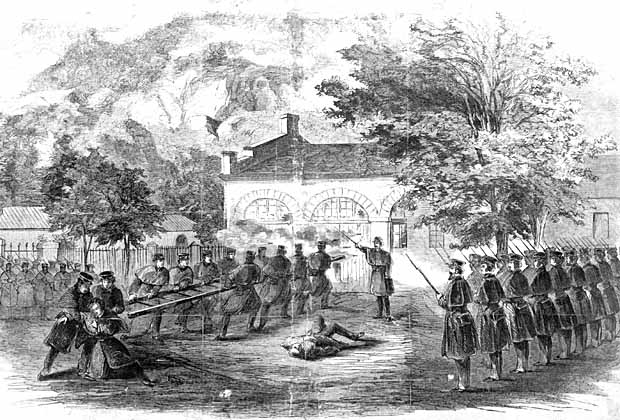The Kansas-Nebraska Act failed to end the national conflict over slavery. Antislavery forces viewed the statute as a capitulation to the South, and many abandoned the Whig and Democratic parties to form the republican party. Kansas soon became a battleground over slavery.
349. Pierce elected President, 1852.--It was now Campaign time for a new election. The Whigs had been successful with two old soldiers, so they thought they would try again with another soldier and nominated General Winfield Scott, the conqueror of Mexico. The Democrats also nominated a soldier, Franklin Pierce of New Hampshire, who had been in northern Mexico with Taylor. The Democrats and Whigs both said that they would stand by the Compromise of 1850. But many voters thought that there would be less danger of excitement with a Democrat in the White House and voted for Pierce for that reason. They soon found that they were terribly mistaken in their belief.
350. Douglas's Nebraska Bill.--President Pierce began his term of office quietly enough. But in 1854 Senator Douglas of Illinois brought in a bill to organize the Territory of Nebraska. It will be remembered that in 1820 Missouri had been admitted to the Union as a slave state. In 1848 Iowa had been admitted as a free state. North of Iowa was the free Territory of Minnesota. Westward from Missouri, Iowa, and Minnesota was an immense region without any government of any kind. It all lay north of the compromise line of 1820 (p. 222), and had been forever devoted to freedom by that compromise. But Douglas said that the Compromise of 1820 had been repealed by the Compromise of 1850. So he proposed that the settlers of Nebraska should say whether that territory should be free soil or slave soil, precisely as if the Compromise of 1820 had never been passed. Instantly there was a tremendous uproar.

351. The Kansas-Nebraska Act, 1854.--Douglas now changed his bill so as to provide for the formation of two territories. One of these he named Kansas. It had nearly the same boundaries as the present state of Kansas, except that it extended westward to the Rocky Mountains. The other territory was named Nebraska. It included all the land north of Kansas and between the Missouri River and the Rocky Mountains. The antislavery leaders in the North attacked the bill with great fury. Chase of Ohio said that it was a violation of faith. Sumner of Massachusetts rejoiced in the fight, for he said men must now take sides for freedom or for slavery. Some, independent Democrats published "An Appeal." They asked their fellow-citizens to take their maps and see what an immense region Douglas had proposed to open to slavery. They denied that the Missouri Compromise had been repealed. Nevertheless, the bill passed Congress and was signed by President Pierce.

352. Abraham Lincoln.--Born in Kentucky, Abraham Lincoln went with his parents to Indiana and then to Illinois. As a boy he was very poor and had to work hard. But he lost no opportunity to read and to study. At the plow or in the long evenings at home by the firelight he was ever thinking and studying. Growing to manhood he became a lawyer and served one term in Congress. The passage of the Kansas-Nebraska Act aroused his indignation as nothing had ever aroused it before. He denied that any man had the right to govern another man, be he white or be he black, without that man's consent. He thought that blood would surely be shed before the slavery question would be settled in Kansas, and the first shedding of blood would be the beginning of the end of the Union.
353. Settlement of Kansas.--In the debate on the Kansas-Nebraska bill Senator Seward of New York said to the Southerners: "Come on, then.... We will engage in competition for the soil of Kansas, and God give the victory to the side that is strong in numbers as it is in right." Seward spoke truly. The victory came to those opposed to the extension of slavery. But it was a long time in coming. As soon as the act was passed, armed "Sons of the South" crossed the frontier of Missouri and founded the town of Atchison. Then came large bands of armed settlers from the North and the East. They founded the towns of Lawrence and Topeka. An election was held. Hundreds of men poured over the boundary of Missouri, outvoted the free-soil settlers in Kansas, and then went home. The territorial legislature, chosen in this way, adopted the laws of Missouri, slave code and all, as the laws of Kansas. It seemed as if Kansas were lost to freedom.

354. The Topeka Convention.--The free-state voters now held a convention at Topeka. They drew up a constitution and applied to Congress for admission to the Union as the free state of Kansas. The free-state men and the slave-state men each elected a Delegate to Congress. The House of Representatives now took the matter up and appointed a committee of investigation. The committee reported in favor of the free-state men, and the House voted to admit Kansas as a free state. But the Senate would not consent to anything of the kind. The contest in Kansas went on and became more bitter every month.
355. The Republican Party.--The most important result of the Kansas-Nebraska fight was the formation of the Republican party. It was made up of men from all the other parties who agreed in opposing Douglas's Kansas-Nebraska policy. Slowly they began to think of themselves as a party and to adopt the name of the old party of Jefferson, Madison, and Monroe--Republican.
356. Buchanan elected President, 1856.--The Whigs and the Know-Nothings nominated Millard Fillmore for President and said nothing about slavery. The Democrats nominated James Buchanan of Pennsylvania for President and John C. Breckinridge of Kentucky for Vice-President. They declared their approval of the Kansas-Nebraska Act and favored a strict construction of the Constitution. The Republicans nominated John C. Frémont. They protested against the extension of slavery and declared for a policy of internal improvements at the expense of the nation. The Democrats won; but the Republicans carried all the Northern states save four.
357. The Dred Scott Decision, 1857.--The Supreme Court of the United States now gave a decision in the Dred Scott case that put an end to all hope of compromise on the slavery question. Dred Scott had been born a slave. The majority of the judges declared that a person once a slave could never become a citizen of the United States and bring suit in the United States courts. They also declared that the Missouri Compromise was unlawful. Slave owners had a clear right to carry their property, including slaves, into the territories, and Congress could not stop them.

358. The Lincoln and Douglas Debates, 1858.--The question of the reëlection of Douglas to the Senate now came before the people of Illinois. Abraham Lincoln stepped forward to contest the election with him. "A house divided against itself cannot stand," said Lincoln. "This government cannot endure half slave and half free.... It will become all one thing or all the other." He challenged Douglas to debate the issues with him before the people, and Douglas accepted the challenge. Seven joint debates were held in the presence of immense crowds. Lincoln forced Douglas to defend the doctrine of "popular sovereignty." This Douglas did by declaring that the legislatures of the territories could make laws hostile to slavery. This idea, of course, was opposed to the Dred Scott decision. Douglas won the election and was returned to the Senate. But Lincoln had made a national reputation.

359. "Bleeding Kansas."--Meantime civil war had broken out in Kansas, Slavery men attacked Lawrence, killed a few free-state settlers, and burned several buildings. Led by John Brown, an immigrant from New York, free-state men attacked a party of slave-state men and killed five of them. By 1857 the free-state voters had become so numerous that it was no longer possible to outvote them by bringing men from Missouri, and they chose a free-state legislature. But the fraudulent slave-state legislature had already provided for holding a constitutional convention at Lecompton. This convention was controlled by the slave-state men and adopted a constitution providing for slavery. President Buchanan sent this constitution to Congress and asked to have Kansas admitted as a slave state. But Douglas could not bear to see the wishes of the settlers of Kansas outraged. He opposed the proposition vigorously and it was defeated. It was not until 1861 that Kansas was admitted to the Union as a free state.

360. John Brown's Raid, 1859.--While in Kansas John Brown had conceived a bold plan. It was to seize a strong place in the mountains of the South, and there protect any slaves who should run away from their masters. In this way he expected to break slavery in pieces within two years. With only nineteen men he seized Harper's Ferry, in Virginia, and secured the United States arsenal at that place. But he and most of his men were immediately captured. He was executed by the Virginian authorities as a traitor and murderer. The Republican leaders denounced his act as "the gravest of crimes." But the Southern leaders were convinced that now the time had come to secede from the Union and to establish a Southern Confederacy.
